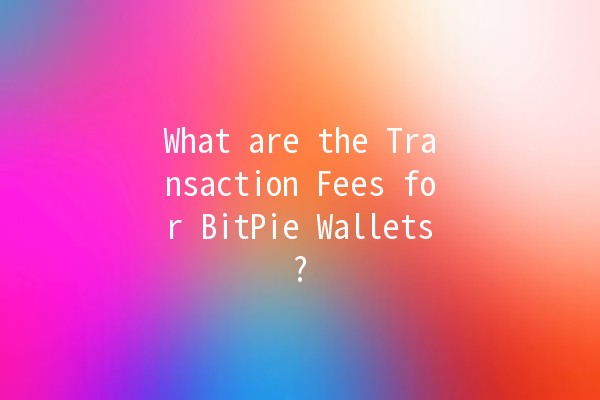
In the expanding world of cryptocurrency, wallets play an essential role in how users store, send, and receive digital assets. One such wallet is BitPie, which has gained traction for its userfriendly interface and variety of features. Understanding the transaction fees associated with the BitPie wallet can help users make informed decisions about their cryptocurrency transactions. This article aims to provide a comprehensive look at BitPie wallet transaction fees, along with productivity tips to enhance your cryptocurrency experience.
Understanding BitPie Wallet Fees
BitPie wallet transaction fees can fluctuate based on various factors, including network congestion, the specific cryptocurrency being transacted, and the wallet’s fee structure. Typically, fees are calculated as a percentage of the transaction amount or as a fixed fee based on the cryptocurrency in question.
For example, the transaction fees for Bitcoin may differ from those for Ethereum or Litecoin, as each cryptocurrency operates on its own underlying protocol. Additionally, when the network is busy, the fees may increase as miners prioritize transactions with higher fees.
Factors Affecting Transaction Costs

Example Fee Structures
To further illustrate how transaction fees work with BitPie, here are some hypothetical examples of fees:
Bitcoin (BTC): A flat fee of 0.0001 BTC per transaction.
Ethereum (ETH): A dynamic fee based on network congestion, typically ranging between 0.001 and 0.005 ETH.
Litecoin (LTC): A standard transaction fee of 0.001 LTC per transaction, with adjustments during peak times.
These examples can help users understand what potential costs might look like in realworld scenarios.
Productivity Tips for Optimizing Your Cryptocurrency Transactions
Now that we've explored transaction fees, let's delve into five productivity tips to help users maximize their experience with cryptocurrency transactions while minimizing costs.
Explanation: Keeping an eye on market conditions can help you time your transactions for the best rates.
Application: Use market tracking tools or websites to analyze cryptocurrency price movements and transaction fees. Execute transactions during offpeak hours when fees may be lower.
Explanation: Not all cryptocurrencies incur the same fees. Choosing the right one for your needs can save you money.
Application: If you need to send money quickly, consider using cryptocurrencies with lower transaction fees during peak times. For instance, if Bitcoin fees are high, opt for Litecoin or Bitcoin Cash instead.
Explanation: Instead of making multiple small transactions, consolidate larger amounts into one transaction.
Application: If you plan to transfer funds to a friend, consider sending one larger transaction instead of several smaller ones to save on fees.
Explanation: Several tools allow you to estimate transaction fees based on current network conditions.
Application: Websites and apps like Mempool.space provide realtime fee estimates for various cryptocurrencies. Use these tools to choose the optimal fee for your transaction.
Explanation: Wallet providers regularly implement updates that can affect fees.
Application: Subscribe to BitPie’s official channels to receive updates on fee changes or new features that could impact your experience.
Common Questions About BitPie Wallet Transaction Fees
Transaction fees in BitPie are calculated based on several factors, including network conditions, the cryptocurrency being used, and the wallet's own fee policies.
Yes, users can reduce transaction fees by choosing the optimal time for transactions, consolidating transactions, and selecting cryptocurrencies that typically incur lower fees.
Absolutely! Different cryptocurrencies have varying fee structures, influenced by their respective blockchain technologies and current market conditions.
BitPie typically does not charge any additional fees aside from the standard network transaction fees. However, it's essential to check for any specific wallet updates or changes.
Transaction times can vary based on network congestion and the fees paid. Generally, transactions with higher fees are processed more quickly than those with lower fees.
BitPie usually allows for custom transaction fee settings, permitting users to choose their fee based on how quickly they want their transaction to be processed.
Understanding transaction fees for BitPie wallets is crucial for any cryptocurrency user. By being informed about how fees work and applying practical tips to manage them, users can significantly enhance their digital asset management experience. In an environment where every transaction counts, staying educated about the nuances of various wallets, including their fees, can lead to smarter, more economical decisions in your cryptocurrency journey.

